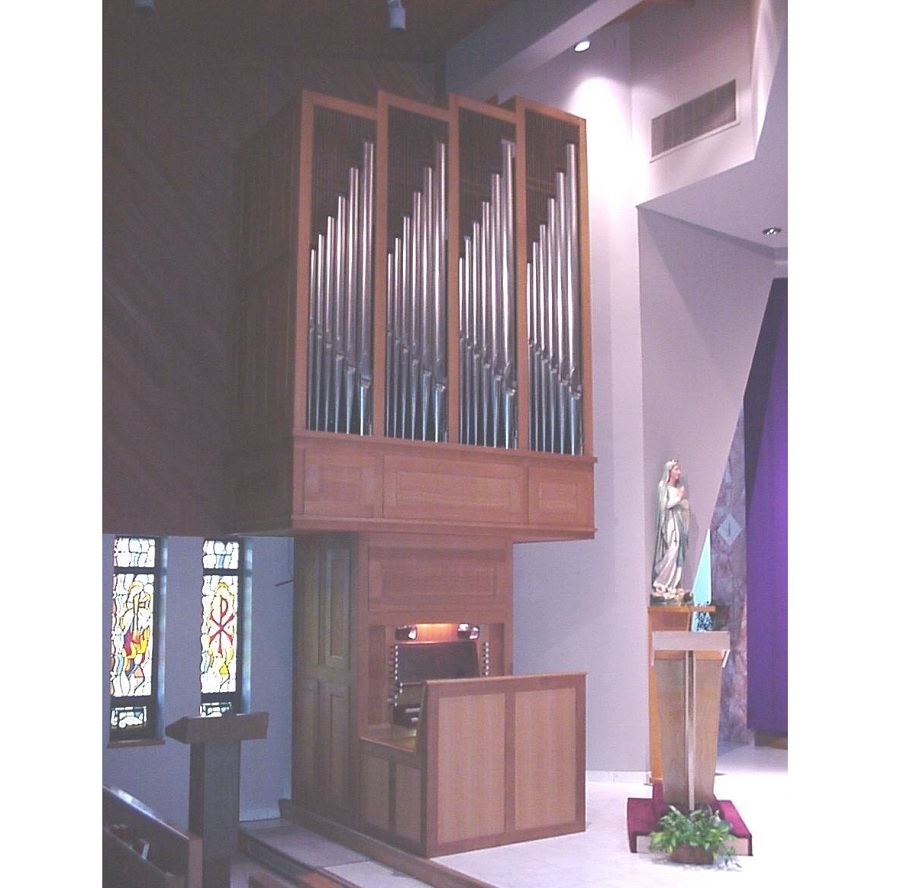Sts. Cyril & Methodius Catholic Church
Sterling Heights, MI, Opus 20, 1996

We designed the new organ for Sts. Cyril & Methodius primarily to
enhance worship in the church, and only secondarily for concert
use. The pastor was very open to placing the organ as near to the
room's main axis as possible, for the best sound dispersion.
The organ case is free-standing. It has a narrow pedestal, taking
up as little floor space as possible. The upper portion is arranged
in four flats of pipes that follow the slope of the ceiling, the
top of the tallest flat being 24 feet off the floor. The case,
although contemporary in style, follows classical principles of
organ construction. There are no internal supports-- the casework
members themselves support the windchest and pipes.
The case is made of quarter-sawn and rift-sawn white oak. Joinery
is pegged mortise and tenon. The pipeshades and console trim are
walnut WPO milled and kiln-dried the majority of the lumber.
Both key action and stop action are mechanical. No electricity is
used except for the blower, tremulant and lighting. Key action is
of the suspended type, a very sensitive action especially
well-known in classical French organs. The drawknobs are arranged
in columns at a 15-degree angle, for the organist's convenience.
The tonal design was done in such a way as to make the organ as
versatile as possible. Both manual divisions are placed on one
windchest, which make sharing some stops possible. Everything
is under expression except the 8' Principal. Three of the stops
are "either/or," which means they may be played on either manual
keyboard, but not both at the same time. The Pedal Bourdon, placed
behind the organ in a shallow chamber, is playable at both 16'
and 8' pitches.
We spend almost 3,000 hours building the organ. David K. Wigton
did the design, some voicing and much construction. However,
many other people were involved in the building and installation:
Jeffrey Perry, casework, chests; Thomas Schuster, racking,
installation; Linda Dzuris, racking. Also involved were Corey
Drayer; Larry Monahan; Margaret Wigton; Anne Marie, Joel and
Elizabeth Wigton; Kenneth and Marie Wigton. Claus and Sharon
Canell of Erie, PA built most of the metal pipes; American Organ
Supply of Milwaukee built the wooden ones. Richard Swanson of
Grand Ledge, MI was responsible for most of the voicing and tonal
finishing. Dr. Marilyn Mason, of the University of Michigan,
was the consultant for the project-- her suggestions and
encouragement were a great help.
STOPLIST Manual I 8' Principal 58 pipes 24 en facade 75% tin, rest 50% tin 8' Chimney Flute58 pipes 12 pipes wood basses; rest 30% tin 4' Octave 58 pipes 50% tin 2' Fifteenth 58 pipes 50% tin Sesquialtera II 104 pipes 30% tin 1-1/3' Mixture II 116 pipes 50% tin 8' Trumpet 58 pipes Zinc and 50% tin 8' Rohrschalmei 58 pipes Brass and 50% tin Manual II 8' Gedackt 46 pipes 1-12 from Manual I; rest wood 8' Viole 58 pipes Zinc and 50% tin 8' Viole Celeste 46 pipes 50% tin 4' Spitzflute 58 pipes 30% tin 2' Gemshorn 58 pipes 30% tin 1-1/3' Larigot 58 pipes 30% tin Sesquialtera II Either/Or 8' Trumpet Either/Or 8' Rohrschalmei Either/Or Pedal 16' Bourdon 30 pipes Stopped Wood 8' Bourdon 12 pipes Stopped Wood Couplers II/I; I/P; II/P, on hitch-down pedals Totals 15 stops, 19 registers, 17-1/2 ranks, 934 pipes Console Features balanced swell pedal; adjustable bench; light for music rack and pedalboard; key naturals of bone, sharps of ebony, pedal naturals of maple, plastic sharps; casework with oil finish, keydesk and bench varnished.

